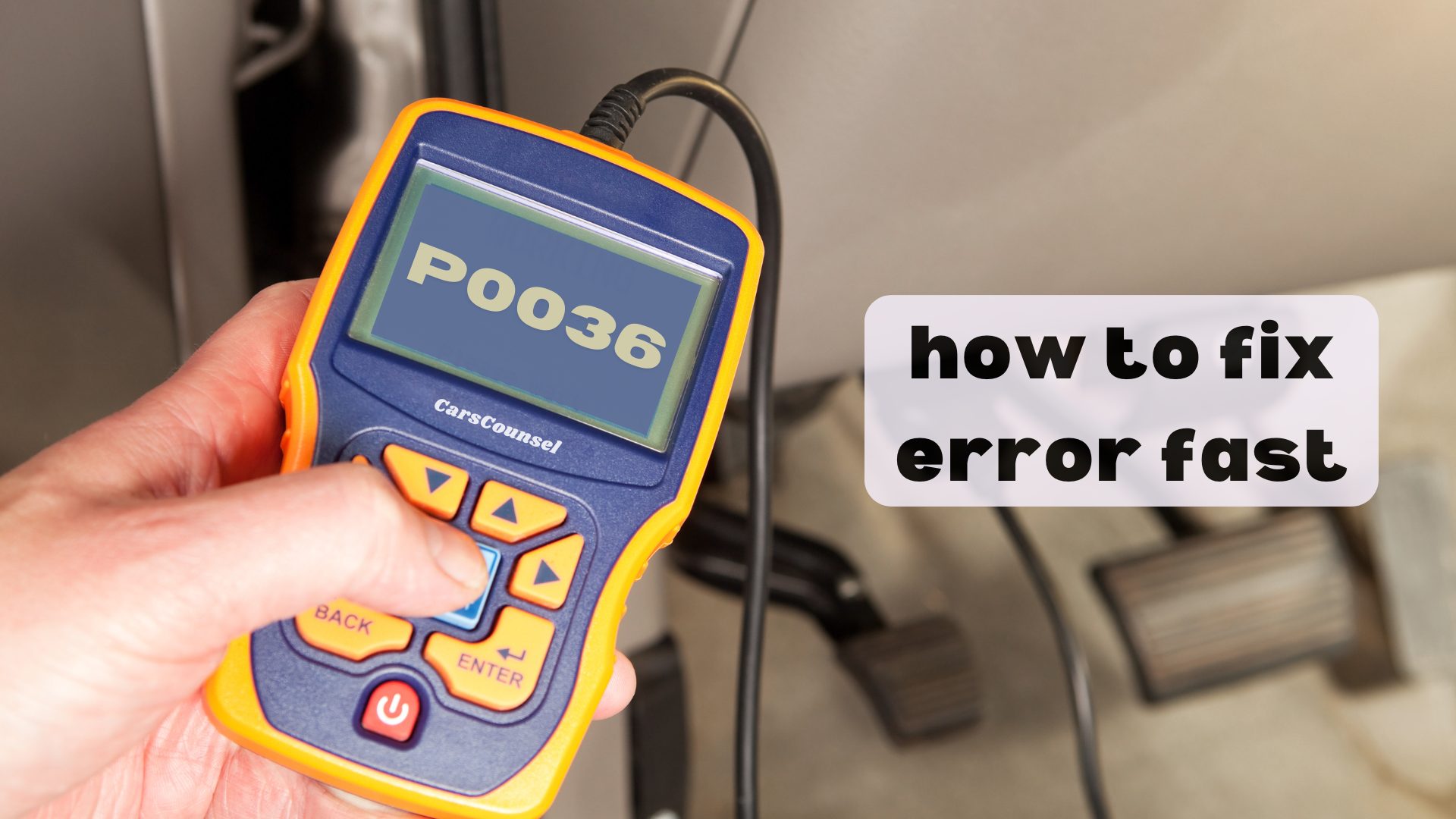When you see the P0036 code, it can be a pain, but fixing it quickly is important to keep your car running well.
Start by confirming the OBD2 Codes error with a diagnostic scanner.
Next, check the heated oxygen sensor for any damage. Use a multimeter to test it, and inspect the wiring and connectors for any signs of corrosion or breaks.
Also, check the relevant fuse and look for any exhaust system leaks.
If these steps don’t fix the problem, you might need to look into the PCM.
Want to know the best way to handle each step?

Quick Navigation
Key Takeaways
- Check Wires and Connections: Look for any damage, rust, or loose connections that could affect the sensor. Fix or replace them if needed.
- Test and Replace the Oxygen Sensor: Use a multimeter to check if the sensor is working. If it’s not, get a new one.
- Check and Replace the Fuse: Look at the fuse linked to the oxygen sensor heater circuit. If it’s blown, put in a new one.
- Fix Exhaust Leaks: Check for any leaks in the exhaust system and fix them so the sensor readings are correct.
What Is P0036 Code?
The P0036 code shows there’s a problem with the heater circuit of the oxygen sensor, which is crucial for the sensor to work well and accurately check exhaust gases. This code means the heater circuit isn’t warming the oxygen sensor properly, affecting its ability to monitor exhaust gases. When this happens, your car might use more fuel and produce more emissions.
To keep your oxygen sensor in good shape, regularly check the sensor and its heater circuit. Look for any damaged wires or connectors and make sure they’re not corroded. Use a multimeter to check if the sensor is working.
If you find any faulty parts, replace them right away. Ignoring this issue can lead to bigger engine problems and expensive repairs. Always stick to your car’s maintenance schedule to avoid these problems and keep your car running smoothly.
Symptoms of P0036 Code
When the heater circuit of the oxygen sensor isn’t working right, you’ll see several signs of a P0036 code.
First, your gas mileage will get worse because the engine computer can’t adjust the fuel properly. You might also notice that the engine runs rough, especially when idling or accelerating.
The check engine light will come on, indicating there’s a problem. Your car will feel sluggish and won’t accelerate as well, and you’ll likely see more emissions, meaning the fuel isn’t burning efficiently.
To fix these issues, make sure to take care of the oxygen sensor and check the exhaust system.
Regular maintenance and timely repairs can keep your car running smoothly and efficiently.
Common Causes of P0036
Several things can cause a P0036 code, including a bad oxygen sensor, damaged wires or connectors, a blown fuse, a failed PCM, high exhaust pressure, and exhaust leaks. Keeping your oxygen sensor in good shape and making sure your exhaust system is intact are key.
Here’s a closer look at common causes:
- Bad Oxygen Sensor: Wear and dirt can make the sensor stop working right, messing up exhaust readings.
- Damaged Wires/Connectors: Rusty or damaged connections can mess up the voltage, affecting how the sensor works.
- Blown Fuse: This cuts off power to the sensor heater circuit, causing it to fail.
- Failed PCM: A malfunctioning Powertrain Control Module can lead to incorrect sensor readings.
- High Exhaust Pressure: This can affect sensor performance and lead to code P0036.
- Exhaust Leaks: Any leaks in the exhaust system can interfere with sensor readings and operation.
Faulty Oxygen Sensor
A bad oxygen sensor often causes the P0036 code because damage or contamination can make it fail to read exhaust gases correctly. Keeping the oxygen sensor in good shape is important to avoid repeated problems. First, check the sensor for any visible damage or dirt. Then, use a multimeter to test if it’s working properly.
| Step | Action |
|---|---|
| 1 | Check the sensor for damage or dirt |
| 2 | Test the sensor with a multimeter |
| 3 | Replace the sensor if it’s faulty |
Following these steps will help you find and fix the problem accurately. Always stick to the manufacturer’s maintenance schedule and deal with any check engine light issues right away to keep your sensor working well and your fuel efficiency high.
Wiring and Connector Issues
Fixing wiring and connector problems is key to solving the P0036 code. Issues like corrosion or damage can mess with the sensor and hurt engine performance.
Start by carefully checking the wiring for any visible damage or frayed wires. Next, look at the connectors for signs of corrosion, which can block electricity from flowing properly. Clean or replace any corroded connectors to ensure a good connection.
Here’s a simple step-by-step guide:
- Check Wiring: Look for any broken, frayed, or exposed wires.
- Look for Corrosion: Check connectors for greenish or whitish deposits.
- Fix or Replace: Repair any damaged wiring and replace connectors if needed.
Making sure the wiring and connections are in good shape will help the oxygen sensor work better and improve engine performance.
Blown Fuse Problems
A blown fuse in the oxygen sensor heater circuit can trigger the P0036 code by cutting off power and stopping the sensor from working properly.
First, find your vehicle’s fuse box, usually located under the dashboard or hood. Check your owner’s manual to identify which fuse is for the oxygen sensor heater circuit. Use a fuse puller or pliers to remove the fuse.
Look at the fuse to see if it’s broken or discolored. If it is, replace it with a fuse that has the same amperage rating.
Make sure to find out why the fuse blew in the first place—check for electrical problems like short circuits or damaged wiring.
After replacing the fuse, use an OBD-II scanner to clear the code and keep an eye on it to make sure the problem is fixed for good.
PCM Failure
One possible reason for the P0036 code is that the Powertrain Control Module (PCM) isn’t working properly and can’t communicate correctly with the oxygen sensor.
Here’s what you should do:
- Check the PCM: Use a diagnostic scanner to see if there are any communication problems between the PCM and the oxygen sensor. Look for any other error codes that might point to an issue with the PCM.
- Replace the PCM: If the diagnostic check shows that the PCM is indeed faulty, you may need to replace it. This usually has to be done by a professional because the new PCM needs to be programmed correctly.
- Recheck the System: After you replace the PCM, make sure everything is working by doing a thorough diagnostic scan to ensure the P0036 code is gone.
These steps can help you quickly fix the problem.
Diagnosing P0036 Code
To diagnose the P0036 code, start by connecting a diagnostic scanner to your car’s OBD-II port to read the error code. Use diagnostic tools to ensure you’re getting accurate information.
Next, check the wiring and connectors for any visible damage or corrosion, which are crucial steps in figuring out the problem. Look at the fuse linked to the oxygen sensor heater circuit to make sure it’s working.
Use a multimeter to test the oxygen sensor by measuring its resistance to see if it’s functioning properly. Also, refer to your car’s service manual for specific diagnostic steps.
Affected Car Models
Certain car models are more likely to have the P0036 code due to their design and environmental factors. Notably, the Vauxhall Astra and Ford Focus often face this issue.
Here are three models and why they’re prone to it:
- Vauxhall Astra: The heater circuit is located near areas with high exhaust pressure, making it vulnerable.
- Ford Focus: This model often has issues with the second oxygen sensor and heater circuit after the catalytic converter.
- Chevrolet Equinox: Like the Ford Focus, this model’s exposure to high exhaust pressure leads to the P0036 code.
Knowing why these models are susceptible can help diagnose and fix the P0036 code more easily.
Fixing P0036 Code
To fix the P0036 code, start by testing the oxygen sensor with a multimeter to make sure it works properly.
Check the resistance of the heater circuit; if it’s an open circuit, the sensor is faulty and needs to be replaced.
Next, look at the wiring and connectors to see if they’re damaged or corroded. Use the multimeter again to check for continuity and proper voltage in the heater circuit. Replace any damaged wires or connectors.
If replacing the oxygen sensor doesn’t solve the problem, check the heater circuit by inspecting the fuse and relay.
Finally, clear the code with an OBD-II scanner and take the car for a test drive to ensure the fix worked.
Regular maintenance can help prevent this issue in the future.
More OBD-II Codes
Frequently Asked Questions
Can Driving With a P0036 Code Damage My Vehicle?
Driving with a P0036 code can harm your vehicle. This issue can cause poor gas mileage, rough running, and more pollution. Fix it soon to avoid more problems and expensive repairs.
How Much Does It Typically Cost to Fix a P0036 Code?
Fixing a P0036 code usually costs between $150 and $500, including the cost of diagnosing the problem. This amount covers the replacement of the oxygen sensor, any needed wiring repairs, and labor costs. Make sure a complete diagnostic is done to avoid spending money on things you don’t need.
Do Aftermarket Oxygen Sensors Affect the Likelihood of a P0036 Code?
When it comes to aftermarket oxygen sensors, you get what you pay for. If they are installed poorly, it can make a P0036 code more likely. Make sure they fit well and are connected properly to avoid rough running and higher emissions.
Are There Temporary Fixes for a P0036 Code?
You can try a quick fix by cleaning the oxygen sensor. First, disconnect the sensor, then use a special cleaner to carefully remove any dirt or grime. After that, reconnect the sensor, clear the error code, and keep an eye on how your car performs. This might temporarily solve the P0036 problem.
Can a P0036 Code Affect My Vehicle’s Emissions Test Results?
Yes, a P0036 code can affect your vehicle’s emissions test results. This code means there’s a problem with the oxygen sensor, which can mess up the fuel combustion process. To pass the emissions test, you need to diagnose and fix the issue.
Conclusion
Think of your car’s oxygen sensor like a guard dog that alerts you to problems. Ignoring the P0036 code is like ignoring that dog’s barking.
By checking the sensor, wires, and exhaust system, you’re giving it the attention it needs to keep your engine running well.
Using a diagnostic scanner is like using a stethoscope to find the issue quickly.
Fixing this code right away ensures your car runs smoothly and helps prevent bigger problems later on.

